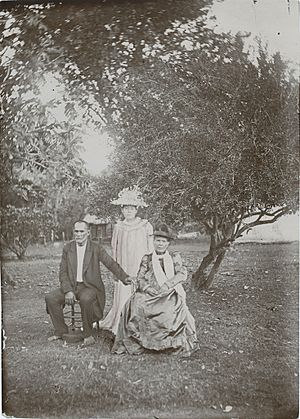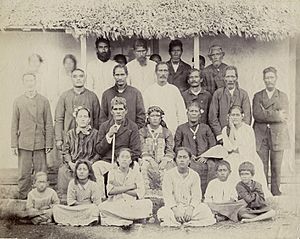Tamaeva V facts for kids
Quick facts for kids Tamaeva V |
|
|---|---|
| Queen of Rimatara | |

Queen Tamaeva V (far right), 1905
|
|
| Reign | 1892–1901 |
| Predecessor | Tamaeva IV |
| Born | c. 1830 |
| Died | 1923 |
| Burial | Royal Sepulchre, Amaru Cemetery |
| Father | Tamaeva II |
Tamaeva V, also known as Heimataura Tamatoa Tamaeva V, was the Queen of the island kingdom of Rimatara. She ruled from 1892 to 1901. Rimatara is a small island in the Austral Islands group. Before becoming queen, she helped rule the island as a regent for the young Queen Tamaeva IV. A regent is someone who governs a kingdom when the true ruler is too young or unable to rule.
Queen Tamaeva V's time as ruler was greatly affected by the French expanding their power in the Pacific Ocean. She and the previous queen, Tamaeva IV, had tried to get help from the British to stop the French. However, this led to France declaring Rimatara a "protectorate" in 1889. This meant France would protect the island, but also control many of its affairs.
In 1901, Queen Tamaeva V gave Rimatara to the French. This made Rimatara part of French Oceania, which is now French Polynesia. She was the last independent ruler in the Austral Islands. Queen Tamaeva V is also famous for helping to save the Rimatara lorikeet, a special bird found on the island, from disappearing forever.
Contents
Early Life on Rimatara
Heimataura was born around 1830 on the Polynesian island of Rimatara. Her father was King Tamaeva II, who was the chief of Rimatara. She grew up during a time when Western ideas and ways of life were changing the island.
Rimatara was one of the last Austral Islands to be found by Western explorers in 1811. Protestantism was brought to the island by missionaries from Tahiti. It quickly became the main religion. By 1856, the small kingdom even had its own flag. A church built in 1857 could hold all 300 people living on the island. The first set of laws for Rimatara was created in 1877.
Serving as a Regent

Rimatara and its neighbor Rurutu were special because they stayed independent for a long time. Other islands, including Tahiti, had already come under French control.
After King Tamaeva II died in 1865, his relative, Tamaeva III, became king. Later, Tamaeva III's daughter, Queen Tamaeva IV, took the throne. Heimataura, who would become Tamaeva V, served as a regent for the teenage Queen Tamaeva IV. In 1892, a French missionary visited Rimatara. He saw the church in Amaru being reopened with a big celebration.
Rimatara and Rurutu tried to ask the British to protect them from the French. However, the French saw this as a threat to their plans in the Pacific. On March 29, 1889, a French warship arrived at Rimatara. The French governor declared Rimatara a French protectorate.
French records say that the queen, the regent, and the chiefs asked the governor to take over the islands. But British records suggest that most islanders did not want this to happen. The protectorate agreement was signed by the French and also by Heimataura and other chiefs. As a sign of the new protectorate, the French flag was added to the corner of Rimatara's flag in 1891.
Queen of Rimatara
Queen Tamaeva IV died young on November 12, 1892. After her death, Heimataura became the Queen of Rimatara, known as Tamaeva V. Even though Rimatara was a French protectorate, she was still allowed to rule. The island kept many of its own laws and its traditional government.
In 1900, the neighboring island of Rurutu became fully part of France. This was done to connect it more closely to Papeete, the main French city in the area. Queen Tamaeva V was the last independent ruler in the Austral Islands. She decided to give Rimatara to France the next year, on June 6, 1901.
On September 2, 1901, Rimatara officially became part of France. The Queen's three children, Narii, Tairiata, and Tamatoa, represented her at the ceremony. The protectorate flag was replaced by the French flag. The people cheered, "Long live the French Republic!" Rimatara then became part of French Oceania, which is now French Polynesia.
Queen Tamaeva V passed away in 1923. She was buried in the Royal Sepulchre at Amaru Cemetery. Her resting place is next to other members of the Tamaeva royal family.
Saving the Rimatara Lorikeet

Queen Tamaeva V is remembered for saving the Rimatara lorikeet (Vini kuhlii). This bird is also called the 'Ura or Kuhl's lorikeet. According to local stories, she saved the bird from disappearing in 1900.
This bird species lived only on Rimatara and some southern Cook Islands. However, its numbers had dropped greatly in the Cook Islands. This was because of black rats that were brought to the islands and too much hunting by people.
Queen Tamaeva V made a special rule called a tapu, or taboo. This rule made it forbidden for anyone from Rimatara to sell, use, or harm the bird. This helped the birds on Rimatara to survive.
In 2007, some of these lorikeets were moved to Atiu in the Cook Islands. Atiu is an island that does not have black rats. This project was done by several groups, including BirdLife International and the San Diego Zoo. By 2008, the birds moved to Atiu were successfully reproducing.
Images for kids




